Cognitive Development in Young Children
VerifiedAdded on 2020/04/01
|7
|2082
|67
AI Summary
This assignment delves into the multifaceted realm of cognitive development in young children. It examines prominent theories such as Piaget's stages of cognitive development and Vygotsky's sociocultural theory. The analysis incorporates research findings on topics like language acquisition, social-emotional development, and the influence of parenting styles. Several influential studies are discussed, shedding light on crucial aspects of early childhood cognitive growth.
Contribute Materials
Your contribution can guide someone’s learning journey. Share your
documents today.

Running Head: NURSING
Nursing
Name of the Student
Name of the University
Author Note
Nursing
Name of the Student
Name of the University
Author Note
Secure Best Marks with AI Grader
Need help grading? Try our AI Grader for instant feedback on your assignments.

1NURSING
Human development involves different age related changes in different stages from birth
until death. The aim of the assignment is to explore this wide area of interest. The main stages in
the human development includes “prenatal development, infancy, childhood (early and middle),
adolescent, adult (early, middle, and late) and old age (death and dying)”. At each stage a person,
gain a capability to survive in life, to thrive, mature and become more competent (Feldman,
2016). Each stage of the development is necessary to understand as these changes takes place
beyond the physical realm ad determine the cognitive and social capabilities. In this assignment,
the focus is on mainly on the cognitive and social development of children. The essay highlights
the factors influencing this development in children.
Different aspects related to brain is considered as cognitive development including
information processing, perceptual skill, language learning and other brain development aspects.
These aspects are important to increase the well being of children and help them grow as
competent adult (Bjorklund & Causey, 2017). Jean Piaget’s cognitive developmental theory
explained four stages of cognitive development. In the first stage called sensorimotor stage (0-2
years), a child collects the sensory data such as touch, smell, hearing, learning and learns the
body movements. In the second stage or pre-operational stage (2-5 years), a child gains
capability to think about objects symbolically and thinking remains egocentric. With memory,
use of matured language, use of symbols the increase in intelligence is demonstrated at this
stage. In the concrete operational stage, for 7-11 years, a child is capable of logical thinking and
demonstrates reversible mental actions. A child at this age is capable of systematic manipulation
of symbols related to objects. The formal operational stage beginning from 11 years onwards
increases the capability in children to learn abstract concepts such love and engage in hypothesis
testing (Modgil et al., 2013). Since Jack is 3 years old, he belongs to pre-operational stage.
Human development involves different age related changes in different stages from birth
until death. The aim of the assignment is to explore this wide area of interest. The main stages in
the human development includes “prenatal development, infancy, childhood (early and middle),
adolescent, adult (early, middle, and late) and old age (death and dying)”. At each stage a person,
gain a capability to survive in life, to thrive, mature and become more competent (Feldman,
2016). Each stage of the development is necessary to understand as these changes takes place
beyond the physical realm ad determine the cognitive and social capabilities. In this assignment,
the focus is on mainly on the cognitive and social development of children. The essay highlights
the factors influencing this development in children.
Different aspects related to brain is considered as cognitive development including
information processing, perceptual skill, language learning and other brain development aspects.
These aspects are important to increase the well being of children and help them grow as
competent adult (Bjorklund & Causey, 2017). Jean Piaget’s cognitive developmental theory
explained four stages of cognitive development. In the first stage called sensorimotor stage (0-2
years), a child collects the sensory data such as touch, smell, hearing, learning and learns the
body movements. In the second stage or pre-operational stage (2-5 years), a child gains
capability to think about objects symbolically and thinking remains egocentric. With memory,
use of matured language, use of symbols the increase in intelligence is demonstrated at this
stage. In the concrete operational stage, for 7-11 years, a child is capable of logical thinking and
demonstrates reversible mental actions. A child at this age is capable of systematic manipulation
of symbols related to objects. The formal operational stage beginning from 11 years onwards
increases the capability in children to learn abstract concepts such love and engage in hypothesis
testing (Modgil et al., 2013). Since Jack is 3 years old, he belongs to pre-operational stage.
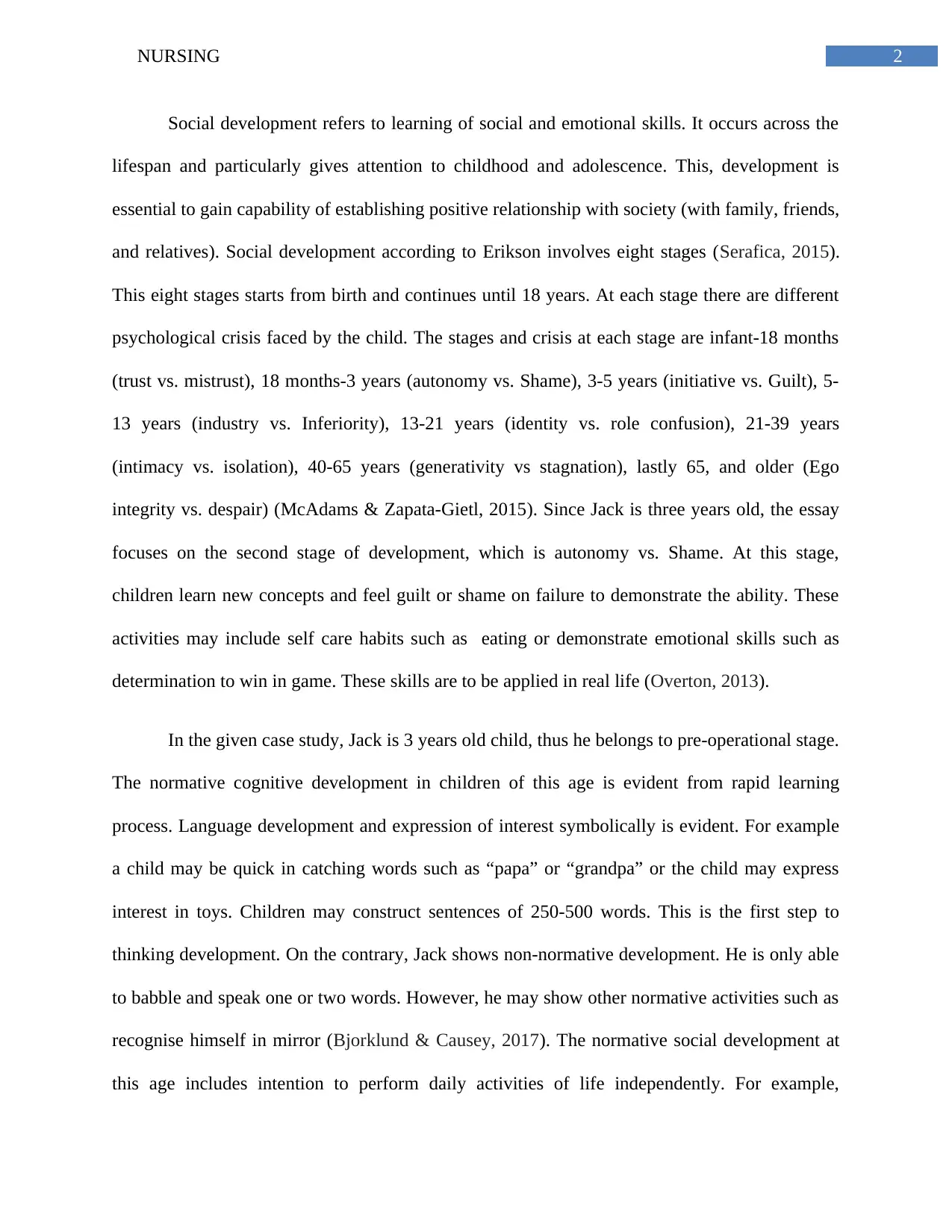
2NURSING
Social development refers to learning of social and emotional skills. It occurs across the
lifespan and particularly gives attention to childhood and adolescence. This, development is
essential to gain capability of establishing positive relationship with society (with family, friends,
and relatives). Social development according to Erikson involves eight stages (Serafica, 2015).
This eight stages starts from birth and continues until 18 years. At each stage there are different
psychological crisis faced by the child. The stages and crisis at each stage are infant-18 months
(trust vs. mistrust), 18 months-3 years (autonomy vs. Shame), 3-5 years (initiative vs. Guilt), 5-
13 years (industry vs. Inferiority), 13-21 years (identity vs. role confusion), 21-39 years
(intimacy vs. isolation), 40-65 years (generativity vs stagnation), lastly 65, and older (Ego
integrity vs. despair) (McAdams & Zapata-Gietl, 2015). Since Jack is three years old, the essay
focuses on the second stage of development, which is autonomy vs. Shame. At this stage,
children learn new concepts and feel guilt or shame on failure to demonstrate the ability. These
activities may include self care habits such as eating or demonstrate emotional skills such as
determination to win in game. These skills are to be applied in real life (Overton, 2013).
In the given case study, Jack is 3 years old child, thus he belongs to pre-operational stage.
The normative cognitive development in children of this age is evident from rapid learning
process. Language development and expression of interest symbolically is evident. For example
a child may be quick in catching words such as “papa” or “grandpa” or the child may express
interest in toys. Children may construct sentences of 250-500 words. This is the first step to
thinking development. On the contrary, Jack shows non-normative development. He is only able
to babble and speak one or two words. However, he may show other normative activities such as
recognise himself in mirror (Bjorklund & Causey, 2017). The normative social development at
this age includes intention to perform daily activities of life independently. For example,
Social development refers to learning of social and emotional skills. It occurs across the
lifespan and particularly gives attention to childhood and adolescence. This, development is
essential to gain capability of establishing positive relationship with society (with family, friends,
and relatives). Social development according to Erikson involves eight stages (Serafica, 2015).
This eight stages starts from birth and continues until 18 years. At each stage there are different
psychological crisis faced by the child. The stages and crisis at each stage are infant-18 months
(trust vs. mistrust), 18 months-3 years (autonomy vs. Shame), 3-5 years (initiative vs. Guilt), 5-
13 years (industry vs. Inferiority), 13-21 years (identity vs. role confusion), 21-39 years
(intimacy vs. isolation), 40-65 years (generativity vs stagnation), lastly 65, and older (Ego
integrity vs. despair) (McAdams & Zapata-Gietl, 2015). Since Jack is three years old, the essay
focuses on the second stage of development, which is autonomy vs. Shame. At this stage,
children learn new concepts and feel guilt or shame on failure to demonstrate the ability. These
activities may include self care habits such as eating or demonstrate emotional skills such as
determination to win in game. These skills are to be applied in real life (Overton, 2013).
In the given case study, Jack is 3 years old child, thus he belongs to pre-operational stage.
The normative cognitive development in children of this age is evident from rapid learning
process. Language development and expression of interest symbolically is evident. For example
a child may be quick in catching words such as “papa” or “grandpa” or the child may express
interest in toys. Children may construct sentences of 250-500 words. This is the first step to
thinking development. On the contrary, Jack shows non-normative development. He is only able
to babble and speak one or two words. However, he may show other normative activities such as
recognise himself in mirror (Bjorklund & Causey, 2017). The normative social development at
this age includes intention to perform daily activities of life independently. For example,
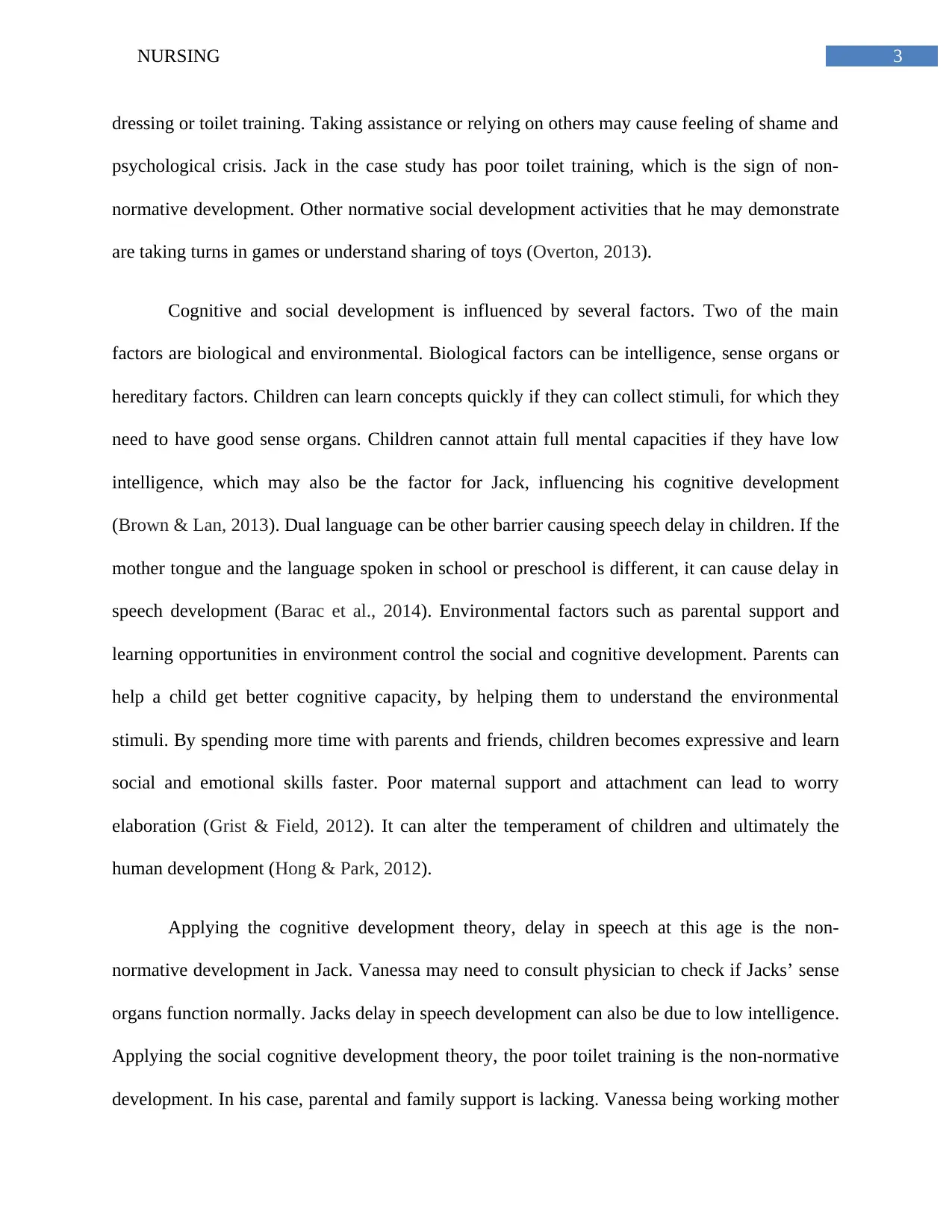
3NURSING
dressing or toilet training. Taking assistance or relying on others may cause feeling of shame and
psychological crisis. Jack in the case study has poor toilet training, which is the sign of non-
normative development. Other normative social development activities that he may demonstrate
are taking turns in games or understand sharing of toys (Overton, 2013).
Cognitive and social development is influenced by several factors. Two of the main
factors are biological and environmental. Biological factors can be intelligence, sense organs or
hereditary factors. Children can learn concepts quickly if they can collect stimuli, for which they
need to have good sense organs. Children cannot attain full mental capacities if they have low
intelligence, which may also be the factor for Jack, influencing his cognitive development
(Brown & Lan, 2013). Dual language can be other barrier causing speech delay in children. If the
mother tongue and the language spoken in school or preschool is different, it can cause delay in
speech development (Barac et al., 2014). Environmental factors such as parental support and
learning opportunities in environment control the social and cognitive development. Parents can
help a child get better cognitive capacity, by helping them to understand the environmental
stimuli. By spending more time with parents and friends, children becomes expressive and learn
social and emotional skills faster. Poor maternal support and attachment can lead to worry
elaboration (Grist & Field, 2012). It can alter the temperament of children and ultimately the
human development (Hong & Park, 2012).
Applying the cognitive development theory, delay in speech at this age is the non-
normative development in Jack. Vanessa may need to consult physician to check if Jacks’ sense
organs function normally. Jacks delay in speech development can also be due to low intelligence.
Applying the social cognitive development theory, the poor toilet training is the non-normative
development. In his case, parental and family support is lacking. Vanessa being working mother
dressing or toilet training. Taking assistance or relying on others may cause feeling of shame and
psychological crisis. Jack in the case study has poor toilet training, which is the sign of non-
normative development. Other normative social development activities that he may demonstrate
are taking turns in games or understand sharing of toys (Overton, 2013).
Cognitive and social development is influenced by several factors. Two of the main
factors are biological and environmental. Biological factors can be intelligence, sense organs or
hereditary factors. Children can learn concepts quickly if they can collect stimuli, for which they
need to have good sense organs. Children cannot attain full mental capacities if they have low
intelligence, which may also be the factor for Jack, influencing his cognitive development
(Brown & Lan, 2013). Dual language can be other barrier causing speech delay in children. If the
mother tongue and the language spoken in school or preschool is different, it can cause delay in
speech development (Barac et al., 2014). Environmental factors such as parental support and
learning opportunities in environment control the social and cognitive development. Parents can
help a child get better cognitive capacity, by helping them to understand the environmental
stimuli. By spending more time with parents and friends, children becomes expressive and learn
social and emotional skills faster. Poor maternal support and attachment can lead to worry
elaboration (Grist & Field, 2012). It can alter the temperament of children and ultimately the
human development (Hong & Park, 2012).
Applying the cognitive development theory, delay in speech at this age is the non-
normative development in Jack. Vanessa may need to consult physician to check if Jacks’ sense
organs function normally. Jacks delay in speech development can also be due to low intelligence.
Applying the social cognitive development theory, the poor toilet training is the non-normative
development. In his case, parental and family support is lacking. Vanessa being working mother
Secure Best Marks with AI Grader
Need help grading? Try our AI Grader for instant feedback on your assignments.
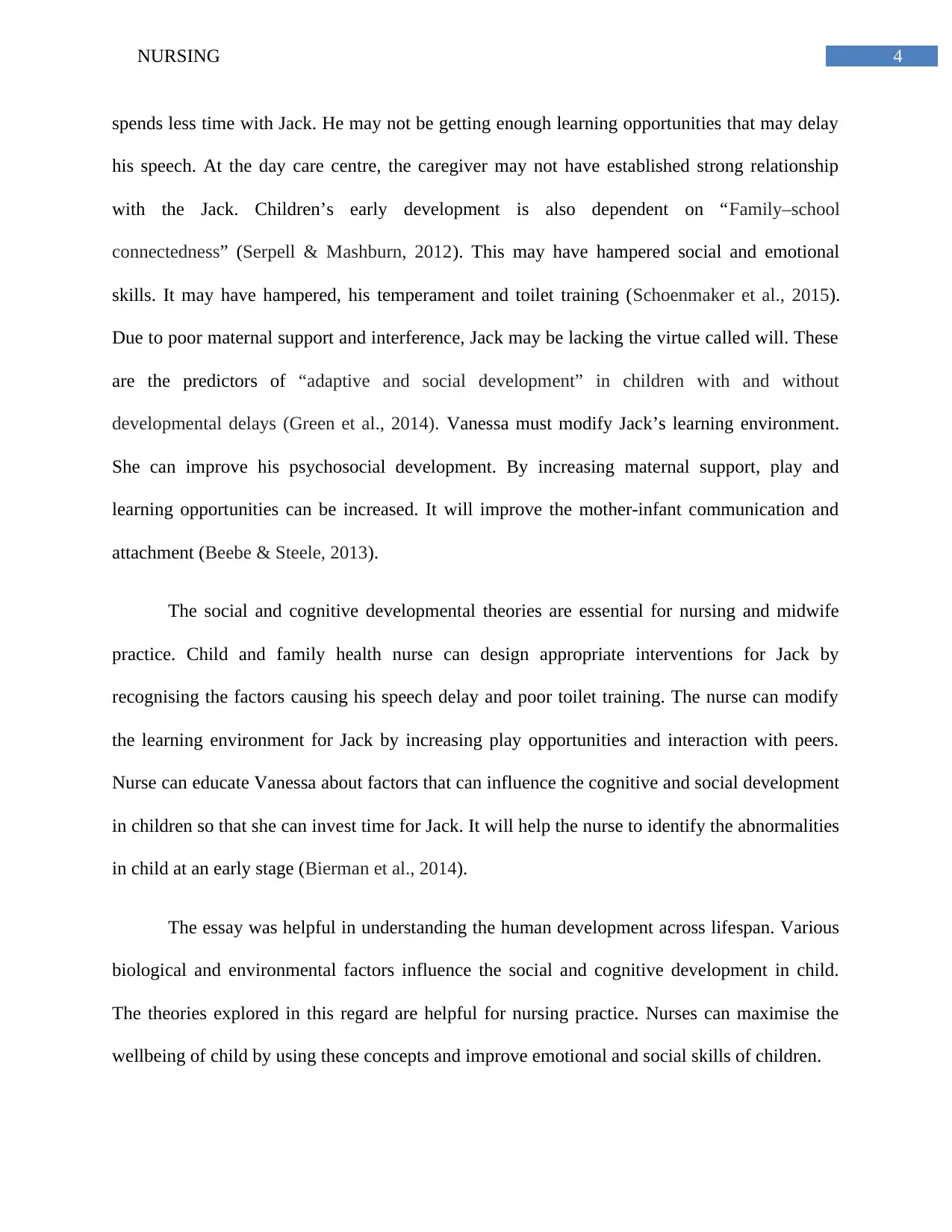
4NURSING
spends less time with Jack. He may not be getting enough learning opportunities that may delay
his speech. At the day care centre, the caregiver may not have established strong relationship
with the Jack. Children’s early development is also dependent on “Family–school
connectedness” (Serpell & Mashburn, 2012). This may have hampered social and emotional
skills. It may have hampered, his temperament and toilet training (Schoenmaker et al., 2015).
Due to poor maternal support and interference, Jack may be lacking the virtue called will. These
are the predictors of “adaptive and social development” in children with and without
developmental delays (Green et al., 2014). Vanessa must modify Jack’s learning environment.
She can improve his psychosocial development. By increasing maternal support, play and
learning opportunities can be increased. It will improve the mother-infant communication and
attachment (Beebe & Steele, 2013).
The social and cognitive developmental theories are essential for nursing and midwife
practice. Child and family health nurse can design appropriate interventions for Jack by
recognising the factors causing his speech delay and poor toilet training. The nurse can modify
the learning environment for Jack by increasing play opportunities and interaction with peers.
Nurse can educate Vanessa about factors that can influence the cognitive and social development
in children so that she can invest time for Jack. It will help the nurse to identify the abnormalities
in child at an early stage (Bierman et al., 2014).
The essay was helpful in understanding the human development across lifespan. Various
biological and environmental factors influence the social and cognitive development in child.
The theories explored in this regard are helpful for nursing practice. Nurses can maximise the
wellbeing of child by using these concepts and improve emotional and social skills of children.
spends less time with Jack. He may not be getting enough learning opportunities that may delay
his speech. At the day care centre, the caregiver may not have established strong relationship
with the Jack. Children’s early development is also dependent on “Family–school
connectedness” (Serpell & Mashburn, 2012). This may have hampered social and emotional
skills. It may have hampered, his temperament and toilet training (Schoenmaker et al., 2015).
Due to poor maternal support and interference, Jack may be lacking the virtue called will. These
are the predictors of “adaptive and social development” in children with and without
developmental delays (Green et al., 2014). Vanessa must modify Jack’s learning environment.
She can improve his psychosocial development. By increasing maternal support, play and
learning opportunities can be increased. It will improve the mother-infant communication and
attachment (Beebe & Steele, 2013).
The social and cognitive developmental theories are essential for nursing and midwife
practice. Child and family health nurse can design appropriate interventions for Jack by
recognising the factors causing his speech delay and poor toilet training. The nurse can modify
the learning environment for Jack by increasing play opportunities and interaction with peers.
Nurse can educate Vanessa about factors that can influence the cognitive and social development
in children so that she can invest time for Jack. It will help the nurse to identify the abnormalities
in child at an early stage (Bierman et al., 2014).
The essay was helpful in understanding the human development across lifespan. Various
biological and environmental factors influence the social and cognitive development in child.
The theories explored in this regard are helpful for nursing practice. Nurses can maximise the
wellbeing of child by using these concepts and improve emotional and social skills of children.
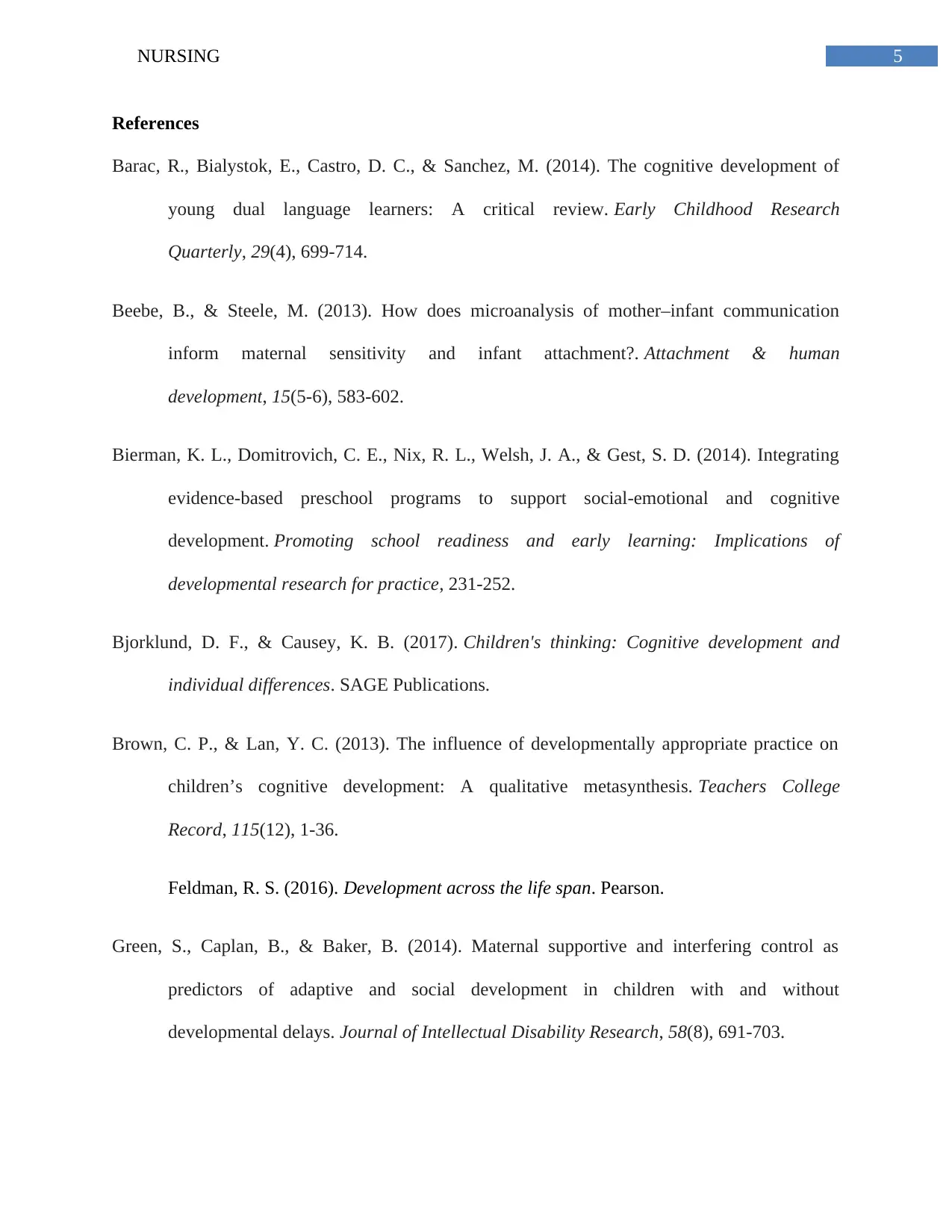
5NURSING
References
Barac, R., Bialystok, E., Castro, D. C., & Sanchez, M. (2014). The cognitive development of
young dual language learners: A critical review. Early Childhood Research
Quarterly, 29(4), 699-714.
Beebe, B., & Steele, M. (2013). How does microanalysis of mother–infant communication
inform maternal sensitivity and infant attachment?. Attachment & human
development, 15(5-6), 583-602.
Bierman, K. L., Domitrovich, C. E., Nix, R. L., Welsh, J. A., & Gest, S. D. (2014). Integrating
evidence-based preschool programs to support social-emotional and cognitive
development. Promoting school readiness and early learning: Implications of
developmental research for practice, 231-252.
Bjorklund, D. F., & Causey, K. B. (2017). Children's thinking: Cognitive development and
individual differences. SAGE Publications.
Brown, C. P., & Lan, Y. C. (2013). The influence of developmentally appropriate practice on
children’s cognitive development: A qualitative metasynthesis. Teachers College
Record, 115(12), 1-36.
Feldman, R. S. (2016). Development across the life span. Pearson.
Green, S., Caplan, B., & Baker, B. (2014). Maternal supportive and interfering control as
predictors of adaptive and social development in children with and without
developmental delays. Journal of Intellectual Disability Research, 58(8), 691-703.
References
Barac, R., Bialystok, E., Castro, D. C., & Sanchez, M. (2014). The cognitive development of
young dual language learners: A critical review. Early Childhood Research
Quarterly, 29(4), 699-714.
Beebe, B., & Steele, M. (2013). How does microanalysis of mother–infant communication
inform maternal sensitivity and infant attachment?. Attachment & human
development, 15(5-6), 583-602.
Bierman, K. L., Domitrovich, C. E., Nix, R. L., Welsh, J. A., & Gest, S. D. (2014). Integrating
evidence-based preschool programs to support social-emotional and cognitive
development. Promoting school readiness and early learning: Implications of
developmental research for practice, 231-252.
Bjorklund, D. F., & Causey, K. B. (2017). Children's thinking: Cognitive development and
individual differences. SAGE Publications.
Brown, C. P., & Lan, Y. C. (2013). The influence of developmentally appropriate practice on
children’s cognitive development: A qualitative metasynthesis. Teachers College
Record, 115(12), 1-36.
Feldman, R. S. (2016). Development across the life span. Pearson.
Green, S., Caplan, B., & Baker, B. (2014). Maternal supportive and interfering control as
predictors of adaptive and social development in children with and without
developmental delays. Journal of Intellectual Disability Research, 58(8), 691-703.
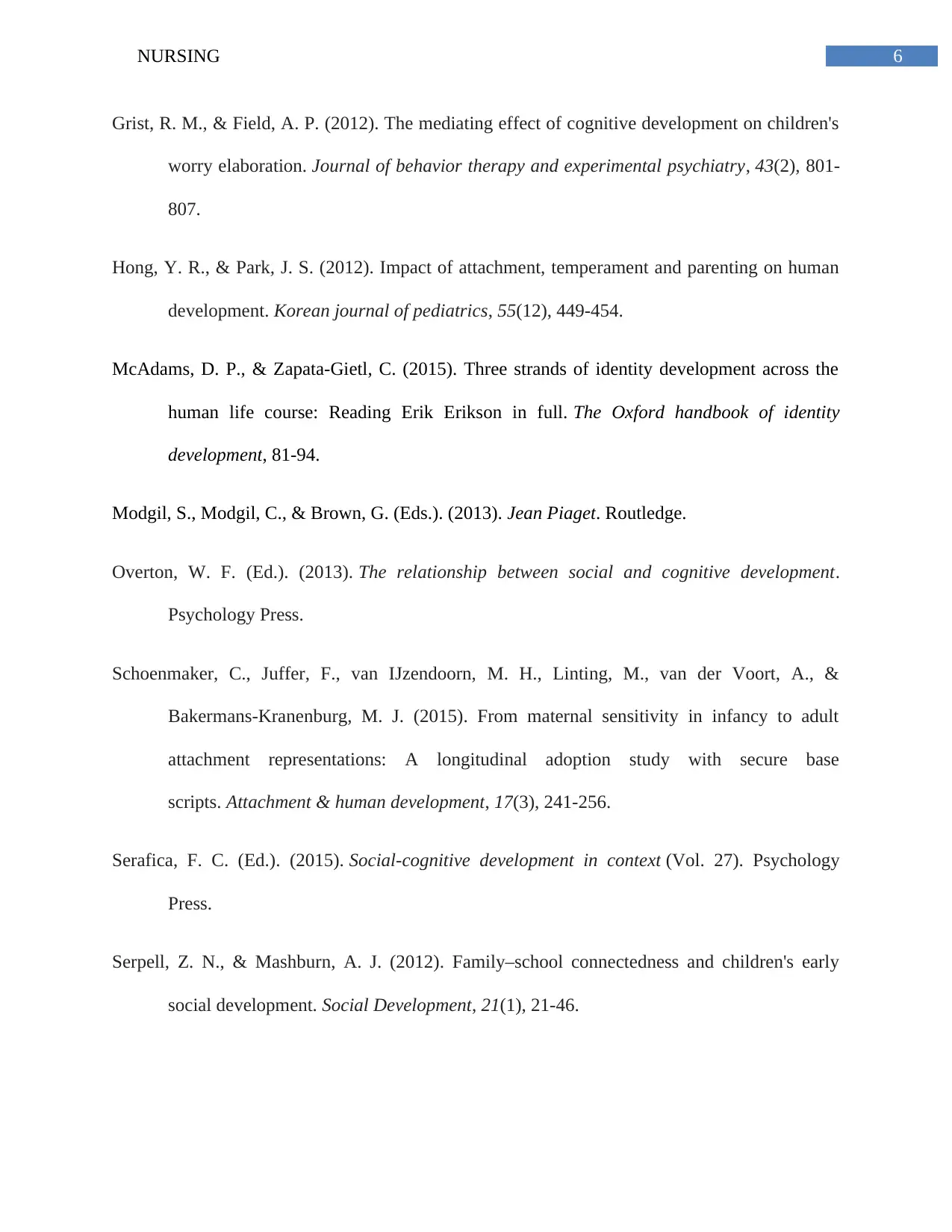
6NURSING
Grist, R. M., & Field, A. P. (2012). The mediating effect of cognitive development on children's
worry elaboration. Journal of behavior therapy and experimental psychiatry, 43(2), 801-
807.
Hong, Y. R., & Park, J. S. (2012). Impact of attachment, temperament and parenting on human
development. Korean journal of pediatrics, 55(12), 449-454.
McAdams, D. P., & Zapata-Gietl, C. (2015). Three strands of identity development across the
human life course: Reading Erik Erikson in full. The Oxford handbook of identity
development, 81-94.
Modgil, S., Modgil, C., & Brown, G. (Eds.). (2013). Jean Piaget. Routledge.
Overton, W. F. (Ed.). (2013). The relationship between social and cognitive development.
Psychology Press.
Schoenmaker, C., Juffer, F., van IJzendoorn, M. H., Linting, M., van der Voort, A., &
Bakermans-Kranenburg, M. J. (2015). From maternal sensitivity in infancy to adult
attachment representations: A longitudinal adoption study with secure base
scripts. Attachment & human development, 17(3), 241-256.
Serafica, F. C. (Ed.). (2015). Social-cognitive development in context (Vol. 27). Psychology
Press.
Serpell, Z. N., & Mashburn, A. J. (2012). Family–school connectedness and children's early
social development. Social Development, 21(1), 21-46.
Grist, R. M., & Field, A. P. (2012). The mediating effect of cognitive development on children's
worry elaboration. Journal of behavior therapy and experimental psychiatry, 43(2), 801-
807.
Hong, Y. R., & Park, J. S. (2012). Impact of attachment, temperament and parenting on human
development. Korean journal of pediatrics, 55(12), 449-454.
McAdams, D. P., & Zapata-Gietl, C. (2015). Three strands of identity development across the
human life course: Reading Erik Erikson in full. The Oxford handbook of identity
development, 81-94.
Modgil, S., Modgil, C., & Brown, G. (Eds.). (2013). Jean Piaget. Routledge.
Overton, W. F. (Ed.). (2013). The relationship between social and cognitive development.
Psychology Press.
Schoenmaker, C., Juffer, F., van IJzendoorn, M. H., Linting, M., van der Voort, A., &
Bakermans-Kranenburg, M. J. (2015). From maternal sensitivity in infancy to adult
attachment representations: A longitudinal adoption study with secure base
scripts. Attachment & human development, 17(3), 241-256.
Serafica, F. C. (Ed.). (2015). Social-cognitive development in context (Vol. 27). Psychology
Press.
Serpell, Z. N., & Mashburn, A. J. (2012). Family–school connectedness and children's early
social development. Social Development, 21(1), 21-46.
1 out of 7
Related Documents
Your All-in-One AI-Powered Toolkit for Academic Success.
+13062052269
info@desklib.com
Available 24*7 on WhatsApp / Email
![[object Object]](/_next/static/media/star-bottom.7253800d.svg)
Unlock your academic potential
© 2024 | Zucol Services PVT LTD | All rights reserved.





